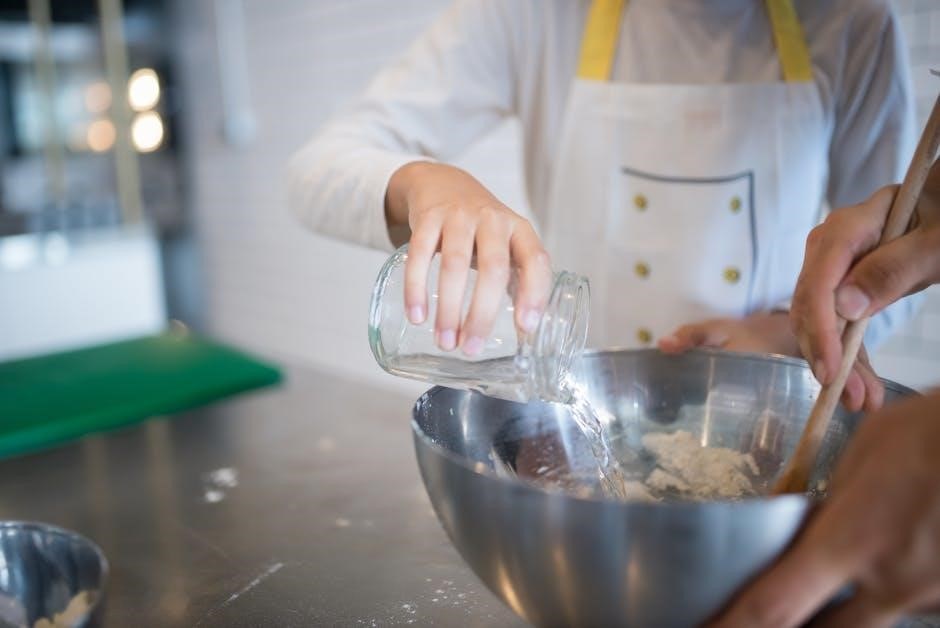5mg semaglutide mixing instructions

Semaglutide is a glucagon-like peptide-1 receptor agonist used for type 2 diabetes management. It is typically available in 5mg formulations, requiring proper mixing with a diluent for administration.
1.1 What is Semaglutide?
Semaglutide is a glucagon-like peptide-1 (GLP-1) receptor agonist, a medication used to treat type 2 diabetes and aid in weight management. It mimics the action of the GLP-1 hormone, which helps regulate blood sugar levels and appetite. Semaglutide is administered via injection and is commonly prescribed in doses of 5mg, requiring proper mixing with a diluent before use. It is known for its ability to improve glycemic control, reduce appetite, and promote weight loss. The medication is typically used once weekly and is part of a broader treatment plan that includes diet and exercise. Proper preparation and administration are essential to ensure its effectiveness and safety.
1.2 Common Uses of Semaglutide
Semaglutide is primarily used to manage type 2 diabetes by improving blood sugar control and reducing the risk of cardiovascular events. It is also prescribed for chronic weight management in adults with obesity. The 5mg formulation is often prescribed for glycemic control, while higher doses may be used for weight loss. Semaglutide works by mimicking the GLP-1 hormone, which regulates appetite and insulin secretion. It is commonly used alongside diet and exercise as part of a comprehensive treatment plan. Additionally, semaglutide has been shown to reduce appetite and aid in weight loss, making it a versatile medication for metabolic health. Its once-weekly administration makes it a convenient option for long-term management of diabetes and weight-related conditions.
1.3 Importance of Proper Mixing
Proper mixing of semaglutide is essential to ensure the medication’s effectiveness and safety. Incorrect preparation can lead to inaccurate dosing, reduced efficacy, or potential contamination. When mixing the 5mg formulation, it is crucial to follow the instructions carefully to achieve the correct concentration and maintain the drug’s stability. Improper mixing may result in uneven distribution of the active ingredient, which can affect how the body absorbs the medication. Additionally, using the wrong diluent or technique can introduce bacteria or other contaminants, posing health risks. Always use sterile water for injection and ensure all equipment is clean and free from contamination. Proper mixing ensures the medication works as intended, providing optimal blood sugar control and weight management benefits. Adhering to the guidelines helps prevent complications and ensures a safe treatment experience.

Safety Precautions
Always handle semaglutide with care to avoid contamination. Wear sterile gloves and work in a clean environment. Avoid skin or eye contact, and use protective gear like goggles. Proper disposal of sharps and materials is essential to prevent injury or exposure. Store unused supplies safely and out of reach of children. Never reuse needles or syringes, and ensure all equipment is properly sterilized before use. Follow all local regulations for disposing of medical waste, and use puncture-proof containers for sharps disposal. Maintain a clean workspace to minimize contamination risks during the mixing process. Proper safety measures ensure a safe and effective treatment experience.
2.1 Handling Guidelines
When handling semaglutide, always ensure the vial and diluent are at room temperature. Clean the vial stopper with an alcohol swab before use. Use sterile water for injection as the diluent to maintain purity. Avoid touching the needle or syringe tip to prevent contamination. Hold the syringe at a slight angle when adding the diluent to the vial. Gently rotate the vial between your palms to mix, avoiding vigorous shaking, which can create bubbles. Never use expired or damaged supplies. If the solution appears cloudy or discolored, discard it immediately. Always inject in a clean, flat area to ensure safety and effectiveness. Follow proper injection technique to minimize discomfort and ensure the medication is administered correctly. Proper handling ensures the integrity of the medication and prevents potential complications.
2.2 Storage Requirements
Store unopened semaglutide vials in the refrigerator at a temperature between 2°C and 8°C. Keep the vial in its original packaging to protect it from light. Do not freeze the medication. Once mixed, the solution should be used immediately or stored in the refrigerator for up to 8 hours. Ensure the mixed solution is clear and free of particles before use. Avoid exposing the medication to extreme temperatures or direct sunlight, as this can affect its potency. Proper storage is essential to maintain the effectiveness and safety of the medication. Always check the expiration date on the vial before use and discard any unused or expired solution. Following these storage guidelines ensures the quality of semaglutide and prevents contamination or degradation.
2.3 Disposal Information
Proper disposal of semaglutide and related materials is crucial for safety and environmental protection. Dispose of used needles, syringes, and empty vials in a puncture-resistant container. Do not flush semaglutide or any medical waste down the drain or toilet, as this can harm the environment. Check local regulations for specific guidelines on disposing of sharps and pharmaceutical waste. Ensure all materials are securely contained to prevent accidental exposure. If unsure about disposal methods, consult a healthcare provider or pharmacist for guidance. Proper disposal helps minimize risks to others and the environment while adhering to legal requirements. Always prioritize safe and responsible waste management when handling semaglutide and its accessories.

Preparation for Mixing
Gather all necessary supplies, including the semaglutide vial, sterile water, syringe, and alcohol swab. Ensure all items are ready before starting the mixing process.
3.1 Gathering Supplies
To mix 5mg semaglutide, gather a semaglutide vial, sterile water for injection, a 3mL syringe, and an alcohol swab. Ensure all items are sterile to prevent contamination.

3.2 Choosing the Right Diluent
For mixing 5mg semaglutide, it is crucial to use the correct diluent to ensure stability and effectiveness. Sterile water for injection is the recommended diluent, as it prevents contamination and maintains the drug’s integrity. Avoid using bacteriostatic water or other diluents, as they may contain preservatives that could interact with semaglutide. Always check the vial label for specific instructions, as some formulations may require a particular diluent. Using the wrong diluent can lead to improper mixing or reduced efficacy of the medication. Ensure the diluent is at room temperature before use to facilitate even dissolution of the powder. Proper diluent selection is the first step in achieving a safe and effective semaglutide solution.
3.3 Sterilization of Equipment
Sterilization of equipment is essential to prevent contamination and ensure a safe mixing process for 5mg semaglutide. Begin by washing your hands thoroughly with soap and water. Use an alcohol swab to clean the vial’s rubber stopper and the injection site. Ensure all utensils, such as syringes and needles, are sterile and used only once. Avoid touching the needle or syringe tip to prevent introducing bacteria. If using a new vial, it is already sterile, but the area around the stopper should still be cleaned. Proper sterilization minimizes the risk of infection and ensures the integrity of the semaglutide solution. Always handle the equipment under aseptic conditions to maintain safety and effectiveness.

Step-by-Step Mixing Instructions
Open the vial, add the diluent, gently mix without shaking, and verify clarity. Ensure the solution is fully dissolved and free of bubbles.
4.1 Opening the Vial
Begin by gathering your supplies, including the semaglutide vial, diluent, syringe, and alcohol swab. Clean the rubber stopper with the swab to ensure sterility. Carefully remove the vial cap, taking note not to touch the stopper to avoid contamination. Gently lift the stopper without twisting or forcing it, as this could damage the vial. Once open, place the vial on a flat, stable surface, ensuring it is upright and not inverted. This step is crucial for maintaining the integrity of the medication and preparing it for the next phase of mixing.
4.2 Adding the Diluent
Once the vial is open, attach the provided syringe to the diluent. Slowly inject the recommended volume of diluent into the semaglutide vial. For a 5mg vial, typically 2.5 mL of bacteriostatic water is used. Hold the vial firmly and insert the needle through the rubber stopper at a slight angle. Gently push the plunger to release the diluent into the vial. Avoid forcefully injecting, as this could create bubbles or foam. Ensure the needle remains submerged to prevent splashing. After adding the diluent, withdraw the needle and carefully set the syringe aside. The solution should begin to dissolve the powder; Allow it to sit for a moment before proceeding to the mixing step. Do not shake the vial vigorously, as this can introduce air bubbles. If bubbles form, gently turn the vial to allow them to rise to the surface. The solution is ready for mixing once fully dissolved. If the solution appears cloudy or contains visible particles, do not use it. Always verify the solution’s clarity before proceeding. Properly adding the diluent ensures the semaglutide is evenly distributed, which is essential for accurate dosing. If unsure, consult the instructions or a healthcare provider for clarification. This step is critical for maintaining the medication’s effectiveness and safety. Proper technique prevents contamination and ensures the solution is ready for administration. Always follow the recommended diluent volume to achieve the correct concentration. This ensures the medication works as intended and minimizes potential side effects. If the vial is not sealed properly after adding the diluent, it may compromise the sterility of the solution. Always handle the vial and syringe with clean hands to reduce contamination risks. The diluent volume should match the product’s specifications to avoid under- or over-dilution. Never use expired diluent or vials, as this can affect the medication’s potency. After adding the diluent, inspect the vial for any visible defects or leakage. If any issues are noticed, do not use the vial and contact the supplier or healthcare provider. Properly adding the diluent is a foundational step in the mixing process, directly impacting the safety and efficacy of the semaglutide solution. Always double-check the diluent volume and technique to ensure accuracy. This step requires attention to detail to maintain the integrity of the medication. If the diluent is added incorrectly, it may render the solution unusable, wasting the medication and requiring a replacement. Always follow the manufacturer’s guidelines for diluent volume and mixing procedures. This ensures the semaglutide is prepared correctly and safely for administration. If unsure about any part of the process, seek guidance from a healthcare professional or pharmacist. They can provide personalized instructions and address any concerns. Properly adding the diluent is essential for achieving the desired concentration and ensuring the medication’s effectiveness. Always prioritize sterility and accuracy during this step to maintain the quality of the semaglutide solution. The diluent should be at room temperature to ensure even mixing and prevent any reactions with the medication; Avoid using hot or cold diluent, as this could affect the stability of the semaglutide. If the diluent is not at room temperature, allow it to sit for a few minutes before use. This helps maintain the medication’s integrity and ensures proper mixing. Never use tap water or other non-sterile liquids as diluents, as they can introduce contaminants and compromise the solution’s safety. Always use the sterile diluent provided or recommended by the manufacturer. This minimizes the risk of contamination and ensures the solution is safe for injection. If the diluent is not sterile, it can lead to serious infections or other complications. Always verify the expiration date of the diluent before use and ensure it is within the recommended range. Expired diluent may not maintain its sterility or effectiveness, which can affect the quality of the semaglutide solution. If the diluent is expired, discard it and obtain a new one before proceeding. Properly adding the diluent is a critical step in preparing semaglutide for injection. Always follow the manufacturer’s instructions and take necessary precautions to ensure the solution is safe and effective. If any step seems unclear or challenging, consult a healthcare professional for assistance. They can provide hands-on guidance and help troubleshoot any issues that arise during the mixing process. Properly adding the diluent ensures the semaglutide is properly reconstituted and ready for administration. Always prioritize accuracy and sterility to maintain the medication’s effectiveness and safety. If the diluent is added incorrectly, it may lead to inconsistent dosing or contamination, which can have serious health consequences. Always double-check the diluent volume and technique before proceeding to the next step. This ensures the semaglutide solution is prepared correctly and safely for use. Properly adding the diluent is essential for achieving the desired results from the medication. Always follow the recommended guidelines and seek professional guidance if needed. This step is crucial for ensuring the quality and safety of the semaglutide solution. If the diluent is not added correctly, it may render the medication ineffective or unsafe to use. Always take the time to carefully follow the instructions and verify each step. Properly adding the diluent sets the foundation for successful mixing and administration of semaglutide. Always prioritize accuracy and attention to detail to ensure the best possible outcomes. If any part of the process feels uncertain, seeking assistance from a healthcare provider or pharmacist is highly recommended. They can offer personalized support and help navigate any challenges encountered during the mixing process. Properly adding the diluent is a vital part of preparing semaglutide for injection. Always adhere to the manufacturer’s instructions and maintain strict sterility to ensure the solution’s safety and effectiveness. If the diluent is added incorrectly, it may compromise the entire preparation process, leading to potential health risks. Always take the necessary precautions and seek guidance if needed. This ensures the semaglutide is prepared correctly and safely for administration. Properly adding the diluent is essential for achieving the intended therapeutic effects of the medication. Always follow the recommended procedures and prioritize sterility to maintain the quality of the solution. If the diluent is not added correctly, it may result in an ineffective or contaminated solution, which can have serious health implications. Always double-check each step and ensure accuracy before proceeding. Properly adding the diluent is a critical step in the preparation of semaglutide for injection. Always adhere to the manufacturer’s guidelines and take necessary precautions to ensure the solution’s safety and effectiveness. If any part of the process is unclear or challenging, seeking assistance from a healthcare professional is strongly advised. They can provide the necessary support and help ensure the medication is prepared correctly. Properly adding the diluent is essential for the successful preparation of semaglutide. Always prioritize accuracy, sterility, and adherence to instructions to achieve the best possible outcomes. If the diluent is added incorrectly, it may lead to inconsistent dosing or contamination, which can negatively impact the medication’s effectiveness and safety. Always take the time to carefully follow the instructions and verify each step. Properly adding the diluent sets the stage for successful mixing and administration of semaglutide. Always maintain attention to detail and ensure the process is completed accurately. If any doubts or concerns arise, consulting a healthcare provider or pharmacist is highly recommended. They can offer expert guidance and help address any issues encountered during the mixing process. Properly adding the diluent is a fundamental step in preparing semaglutide for injection. Always follow the manufacturer’s instructions and prioritize sterility to ensure the solution is safe and effective. If the diluent is not added correctly, it may compromise the entire preparation process, leading to potential health risks. Always take the necessary precautions and seek guidance if needed. This ensures the semaglutide is prepared correctly and safely for administration. Properly adding the diluent is essential for achieving the intended therapeutic effects of the medication. Always follow the recommended procedures and prioritize sterility to maintain the quality of the solution. If the diluent is not added correctly, it may result in an ineffective or contaminated solution, which can have serious health implications. Always double-check each step and ensure accuracy before proceeding. Properly adding the diluent is a critical step in the preparation of semaglutide for injection. Always adhere to the manufacturer’s guidelines and take necessary precautions to ensure the solution’s safety and effectiveness. If any part of the process is unclear or challenging
4.3 Mixing the Solution
After adding the diluent, gently swirl the vial in a circular motion for about 10 seconds to mix the solution. Avoid shaking vigorously, as this may create bubbles. Allow the vial to sit for 2-3 minutes to ensure the powder dissolves completely. If small bubbles form, they will typically dissipate on their own. Do not inject the solution if it appears cloudy, discolored, or contains visible particles. Once fully dissolved, the solution should be clear and free of sediment. To confirm, gently invert the vial to check for any remaining powder. If the solution is not fully dissolved, repeat the swirling process but do not over-agitate. Proper mixing ensures even distribution of the medication, which is critical for accurate dosing. If unsure, consult the instructions or a healthcare provider for guidance. Patience and attention to detail are key to achieving a safe and effective mixture.
4.4 Verifying the Mixture
After mixing, inspect the solution visually. Ensure it is clear, colorless, and free from visible particles or bubbles. If the solution appears cloudy, discolored, or contains sediment, do not use it. Gently tilt the vial to check for any remaining powder or unevenness. Proper verification ensures the solution is safe and effective for injection. If unsure about the appearance, consult the instructions or contact a healthcare provider. Avoid using the solution if it does not meet these criteria, as this could affect its potency or safety. Verification is a critical step to guarantee accurate dosing and optimal therapeutic results. Always prioritize caution and seek guidance if in doubt.

Administration Guidelines
Administer semaglutide via subcutaneous injection, typically in the abdomen or thigh. Inject once weekly at the same time, following proper technique to minimize discomfort and ensure efficacy.

5.1 Injection Technique
Proper injection technique is crucial for safe and effective administration of semaglutide. Choose an injection site, such as the abdomen or thigh, and clean it with an alcohol swab. Pinch the skin to form a fold, then insert the needle at a 45-degree angle; Slowly inject the entire dose into the subcutaneous tissue. Avoid injecting into muscle or blood vessels. Hold the skin fold until the injection is complete to prevent leakage. Rotate injection sites to minimize the risk of lipodystrophy. Always follow the healthcare provider’s instructions and handle the syringe carefully to avoid accidental needlestick injuries. Proper technique ensures optimal absorption and minimizes discomfort or complications.
5.2 Recommended Injection Sites
The recommended injection sites for semaglutide include the abdomen, thigh, or upper arm. The abdomen is the most common site due to its large subcutaneous tissue area, ensuring proper absorption. The thigh is another suitable option, particularly for those with less abdominal fat. The upper arm is ideal for individuals who prefer assistance from a caregiver. Regardless of the site chosen, it is essential to rotate injection locations to avoid lipodystrophy, a condition where the subcutaneous tissue changes texture. Always clean the injection site with an alcohol swab before administering the dose. If unsure about the best injection site, consult your healthcare provider for personalized guidance. Proper site selection enhances the medication’s effectiveness and minimizes potential side effects.
5.3 Timing and Frequency
Semaglutide is typically administered once weekly, with no specific requirement for fasting. It is recommended to inject the medication at the same time each week to maintain consistent drug levels. Timing can be flexible, but consistency is key to optimizing its effectiveness. The injection should be given subcutaneously, preferably in the morning or evening, depending on personal preference. Administering it on the same day each week helps establish a routine and improves adherence. If a dose is missed, it should be taken as soon as remembered, provided it is within a few days of the scheduled dose. Avoid doubling up on doses to prevent potential side effects. Consulting a healthcare provider is advised for any changes in timing or frequency to ensure proper glucose control and minimize adverse reactions. Proper timing enhances therapeutic outcomes and safety.

Common Mistakes to Avoid
- Over-mixing can cause bubbles, affecting dosage accuracy.
- Using incorrect diluent volume may alter concentration.
- Improper injection technique can lead to discomfort or reduced efficacy.
6.1 Over-Mixing the Solution
Over-mixing the semaglutide solution can introduce air bubbles, potentially altering the dosage accuracy. Gently rotate the vial to dissolve the powder without vigorous shaking. This ensures a uniform solution and prevents foam formation, which can affect the administered dose. Proper mixing technique is crucial for maintaining the medication’s efficacy and safety. Always follow the recommended mixing procedure to avoid such issues.
6.2 Using Incorrect Diluent Volume
Using the incorrect volume of diluent when mixing semaglutide can lead to an inaccurate concentration of the medication. This may result in improper dosing, potentially affecting its efficacy or safety. Always use the recommended amount of sterile water or diluent specified by the manufacturer or healthcare provider. For a 5mg semaglutide vial, the typical diluent volume is pre-determined to ensure the correct concentration. Measuring the diluent precisely is crucial to avoid under-dilution or over-dilution, both of which can compromise the treatment’s effectiveness. Refer to the product’s instructions or consult a healthcare professional if unsure about the correct volume to use.
6.3 Improper Injection Technique
Improper injection technique can lead to discomfort, reduced efficacy, or increased risk of side effects when administering semaglutide. Common mistakes include injecting too quickly, using the wrong needle size, or not following the recommended injection depth. Ensure the needle is inserted at the correct angle ( typically 90 degrees for subcutaneous injections) and that the injection is performed in a steady, controlled manner. Using a needle that is too short or too long can also affect the delivery of the medication. Always follow the specific instructions provided by your healthcare provider or the medication’s guidelines. Practicing proper technique ensures the medication is administered safely and effectively, minimizing potential issues like pain or swelling at the injection site.

Troubleshooting
Address common issues like clumps or incomplete dissolution by gently swirling the vial. Ensure proper dilution and avoid contamination by using sterile techniques and supplies.
7.1 Dealing with Bubbles in the Solution

If bubbles form during mixing, gently tap the vial or allow it to sit for a few minutes. Avoid shaking vigorously, as this can introduce more air.
7.2 Addressing Incomplete Dissolution
If the semaglutide powder does not fully dissolve, avoid shaking the vial vigorously. Instead, gently rotate it between your palms or let it sit for a few minutes. Ensure the diluent is added slowly to prevent clumping. If particles remain, the solution may not be used, as incomplete dissolution can affect potency. Always follow the recommended mixing technique to ensure the medication is homogeneous and ready for injection. Proper preparation is crucial for therapeutic effectiveness and safety. If unsure, consult a healthcare provider or pharmacist for guidance.
7.3 Managing Contamination Risks
Contamination during the mixing process can compromise the safety and efficacy of semaglutide. Always use sterile supplies, including the diluent, syringe, and needles. Ensure the mixing area is clean and free from dust or germs. Before adding the diluent, inspect the vial for any visible particles or discoloration. If contamination is suspected, discard the solution and prepare a fresh batch using a new vial and supplies. Never use a contaminated solution, as it can lead to infections or reduced medication effectiveness. Proper handwashing and the use of gloves are essential to minimize contamination risks. If unsure about the sterility of the solution, consult a healthcare professional for guidance.
Proper mixing of 5mg semaglutide is crucial for safe and effective use. Always follow guidelines, ensure sterility, and consult a healthcare provider if unsure. Proper technique ensures optimal results.
8.1 Summary of Key Points
Proper preparation and mixing of 5mg semaglutide are essential for safe and effective use. Always gather the necessary supplies, including the vial, sterile water, and syringes. Ensure the diluent volume matches the recommended guidelines to maintain the solution’s potency. Follow aseptic technique to prevent contamination and verify the mixture for clarity before administration. Adhere to the prescribed injection technique and timing to maximize therapeutic benefits. Avoid common mistakes such as over-mixing or using incorrect diluent volumes, which can compromise the medication’s efficacy. If issues arise, address them promptly, such as dealing with bubbles or incomplete dissolution. Consulting a healthcare provider for any concerns ensures proper usage and optimal outcomes.
8.2 Final Tips for Success
For successful semaglutide mixing, ensure all supplies are ready and use the correct diluent volume. Clean the vial top with an alcohol swab and allow it to dry. Add the recommended diluent slowly, then mix gently by rolling the vial between your palms to avoid bubbles. Verify the solution is clear and free of particles. Store the mixed solution in the refrigerator and use it within the recommended timeframe. Practice proper injection technique, injecting into the abdomen, thigh, or upper arm, and maintain consistent timing for administration. Monitor for side effects and consult your healthcare provider immediately if any issues arise. Always follow guidelines to ensure safety and efficacy.
8.3 Importance of Following Guidelines
Adhering to the mixing and administration guidelines for 5mg semaglutide is crucial for both safety and effectiveness. Proper preparation ensures the drug’s potency and prevents contamination, which can lead to serious health risks. Following the recommended dilution volume and mixing technique helps maintain the solution’s stability and prevents issues like incomplete dissolution or bubble formation. Additionally, storing the mixed solution correctly in the refrigerator and using it within the specified timeframe guarantees its efficacy. Neglecting these steps could result in reduced therapeutic benefits or potential side effects. Always refer to the provided instructions and consult your healthcare provider if unsure. Consistent adherence ensures optimal blood sugar control and minimizes complications. Proper protocol compliance is essential for patient safety and treatment success.